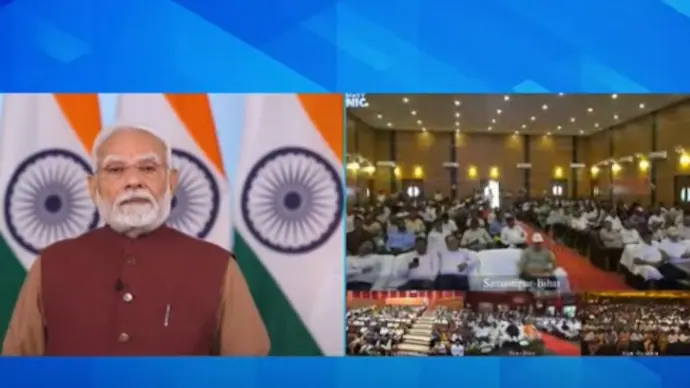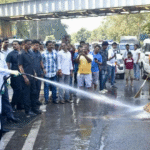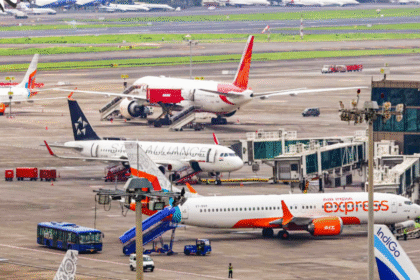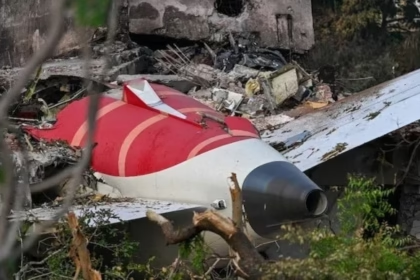PM Modi Hands Over 51,000 Job Letters Under Rozgar Mela; 10 Lakh Recruited So Far
On July 12, 2025, Prime Minister Narendra Modi handed over 51,000 appointment letters to newly recruited individuals across various government departments and public sector units under the ongoing Rozgar Mela initiative. With this milestone, the total number of appointments made under the Rozgar Mela scheme crossed the 10-lakh mark, signaling one of the most ambitious direct employment efforts undertaken by the Indian government in recent decades.
The Rozgar Mela, first launched in 2022, was envisioned not merely as a hiring initiative, but as a systemic intervention into India’s employment ecosystem. It seeks to address not only immediate job creation in the public sector, but also to restore public faith in structured recruitment, transparent selection mechanisms, and meritocratic governance.
In this ten-part series, we will explore the evolution, structure, challenges, and long-term implications of the Rozgar Mela. We will also unpack its impact on the job market, what it means for aspirants, and how it aligns with the broader goals of India’s socio-economic transformation.
A Vision for Empowerment: Why Rozgar Mela Was Launched
India’s population pyramid is overwhelmingly youthful. With over 65% of its population below the age of 35, the country is uniquely positioned to harness the energy and productivity of its youth. However, that opportunity is not without its challenges. For years, the central concern among India’s emerging workforce has been unemployment or underemployment—especially among educated youth.
The Rozgar Mela emerged as a direct response to these anxieties. Announced in mid-2022 and scaled aggressively after 2023, it aims to:
- Streamline recruitment into central government departments and PSUs
- Address staffing gaps across ministries including Railways, Defence, Home Affairs, and Education
- Establish a regularized, time-bound hiring process with minimal bureaucratic lag
- Boost public confidence in government-backed employment
- Counterbalance private sector hiring slowdowns in key industries
The Rozgar Mela is not just a jobs program. It’s a signal—of governance that delivers, of systems that respond, and of a political commitment to tackle unemployment structurally.
The Scale and Structure of the 2025 Appointment Drive
The handover of 51,000 appointment letters in July 2025 was conducted virtually, with the Prime Minister interacting with select recruits via video conferencing. Events were held simultaneously at 45 locations across the country, coordinated by central ministries and nodal officers.
The key highlights of the 2025 Rozgar Mela wave include:
- Total job letters issued (July 2025 round): 51,000
- Cumulative appointments under Rozgar Mela since 2022: 10,00,000+
- Participating ministries: Defence, Railways, Labour and Employment, Home Affairs, Education, Health, and others
- Designations filled: Clerical staff, constables, assistant section officers, junior engineers, teachers, medical officers, and administrative personnel
- Selection mechanisms: Through UPSC, SSC, Railway Recruitment Board, and departmental exams
The scale and uniformity of the drive reflect an effort to centralize and digitize government hiring, improving accountability, visibility, and reach—especially in semi-urban and rural areas.
PM Modi’s Message: Youth at the Heart of India’s Growth Story
In his address to the new appointees, PM Modi emphasized that government jobs are not just sources of income—they are vehicles for national service. He noted:
“Each appointment handed out today is a symbol of the trust this nation places in its youth. You are not merely employees—you are contributors to India’s Viksit Bharat vision.”
This message is consistent with the larger narrative that PM Modi has built over the past few years: of positioning India’s youth not as dependents needing welfare, but as pillars of national strength who must be provided with platforms, training, and responsibility.
He also reiterated the government’s commitment to increasing efficiency in public administration, saying that newly inducted employees would be trained through the Karmayogi digital learning platform, designed to improve service delivery and productivity in government roles.
The 10-Lakh Milestone: Numbers That Matter
Crossing the 1 million recruitments mark under a single initiative is no small feat. It places the Rozgar Mela in the league of the largest public-sector hiring programs globally. To contextualize:
- Between 2014–2021, central government hiring averaged 1.2–1.5 lakh per year, often with large delays in final appointments
- Rozgar Mela alone has added 10 lakh new government employees in three years—a five-fold increase in pace
- The program has targeted Grade C and D vacancies, often neglected in earlier drives but crucial for operational efficiency
- Women candidates and SC/ST/OBC applicants have seen increased representation, owing to mandated reservation compliance and digital outreach campaigns
The numbers indicate more than quantity—they suggest a policy shift toward restoring confidence in public employment as a viable and desirable career path.
Operational Execution: Digitization, Monitoring, and Departmental Coordination
One of the distinguishing features of Rozgar Mela is its digitally-enabled, multi-agency coordination model. Unlike past recruitment efforts that were plagued by paperwork and delays, this program is:
- Integrated with NIC (National Informatics Centre) systems for document verification
- Aligned with the DoPT’s central dashboard for vacancy tracking and status updates
- Linked to MyGov and DigiLocker for seamless sharing of appointment letters and offer details
- Supported by quarterly review meetings between the Prime Minister’s Office and senior departmental secretaries
This degree of operational monitoring ensures that vacancies are not only advertised but filled within six months, a major departure from the earlier 2–3 year wait periods in some ministries.
Voices from the Ground: Recruits Reflect on Opportunity
New recruits shared stories of years of hard work, coaching struggles, financial uncertainty, and finally—hope. For many, especially those from rural or underrepresented backgrounds, a government job is not just economic security—it is social mobility.
Rupa Kumari, a newly appointed postal assistant from Bihar, shared:
“My father is a farmer. This job means stability not just for me, but for my entire family. The process was fair, timely, and transparent.”
Others echoed this sentiment, noting that the digital application and interview system made the process accessible and fairer than earlier years.
A Foundation for Reform, Not Just Recruitment
The Rozgar Mela is a clear statement of intent—of a government looking to rebuild trust in public systems, restore dignity to public service, and reduce youth unemployment through direct state action. With 10 lakh jobs already distributed and more rounds scheduled through 2025–26, this could become a blueprint for sustainable public sector workforce renewal.
From Vision to Rollout: How Rozgar Mela Took Shape Amid India’s Employment Crisis
The Rozgar Mela initiative, now hailed as a cornerstone of the Indian government’s direct job creation strategy, didn’t emerge overnight. It was born in the crucible of post-pandemic uncertainty, economic recalibration, and a mounting national conversation around unemployment. In this part, we trace how the scheme was envisioned, structured, and implemented—from Cabinet-level ideation to cross-ministerial execution—and examine its place in India’s broader labor market reform.
The Backdrop: A Shifting Economic and Political Landscape
By mid-2021, India was facing a complex employment challenge. The COVID-19 pandemic had upended both formal and informal sectors, leaving millions of workers jobless. While the economy gradually rebounded in late 2021 and 2022, employment recovery lagged behind GDP recovery. Informal workers were reabsorbed slowly, and private-sector hiring remained conservative amid global inflation and supply chain disruptions.
At the same time, public trust in government recruitment systems was eroding. Scams, examination delays, paper leaks, and pending vacancies in key departments created a vacuum of confidence—particularly among youth who had spent years preparing for civil services and government job exams.
These two fault lines—structural unemployment and institutional distrust—set the stage for an aggressive public sector employment strategy. Rozgar Mela emerged as a direct answer to both challenges, promising scale, speed, and system-wide transparency.
The Conceptual Blueprint: Job Creation as State Responsibility
The idea behind Rozgar Mela was clear: if the private sector is temporarily cautious in hiring, the state must step in as the principal employer, especially for entry-level and essential service positions. But more than that, it had to:
- Deliver jobs across geographies, especially in states with higher unemployment rates
- Integrate technology into hiring, avoiding the inefficiencies of manual recruitment
- Encourage departments to identify and expedite long-pending vacancies
- Demonstrate the government’s commitment to youth employment through symbolic and measurable action
- Do all of the above without creating long-term fiscal drag, by ensuring the hires are necessary, budgeted, and trained
Thus, Rozgar Mela was not just a hiring spree—it was restructuring the public recruitment process as a show of good governance.
Planning the Machine: How Departments Were Mobilized
A task force was created in early 2022 under the Department of Personnel and Training (DoPT) to track sanctioned vacancies across central government ministries and PSUs. The first step involved:
- Auditing department-wise vacant positions, especially Group B and C
- Identifying roles critical to service delivery (postal services, police, railways, public health)
- Coordinating with Union Public Service Commission (UPSC), Staff Selection Commission (SSC), and Railway Recruitment Boards (RRBs) to expedite exam cycles
- Collaborating with NIC and MyGov platforms for digital applications, verification, and dashboards
- Creating templates for appointment letters, digital onboarding, and role-specific training modules
The final model envisioned a recurring, quarterly cycle of recruitment coordinated centrally but executed departmentally—with the PMO maintaining oversight.
Symbolism and Scale: Why the PM Personally Hands Over Letters
From the very first round in October 2022, Prime Minister Modi’s decision to personally hand over appointment letters—even if virtually—was a calculated political and symbolic act. It conveyed:
- That the highest office of the land cares directly about youth employment
- That the process was top-priority, not a bureaucratic formality
- That each job appointment was a moment of pride, not charity
- That governance could be made visible, measurable, and accountable
It also helped the government narratively distinguish Rozgar Mela from earlier hiring drives. This wasn’t just about statistics—it was about personalized recognition of talent, merit, and national contribution.
A New Pipeline: The Role of Technology in Recruitment Reform
Unlike in the past, when paper-based exams and interviews caused bottlenecks, Rozgar Mela’s tech-first approach made the process faster and fairer. Key innovations included:
- Online application platforms integrated with Aadhaar for identity verification
- Use of AI-based proctoring in online exams and video interviews
- Immediate publishing of merit lists, appointment letters via DigiLocker, and role-specific instructions
- Training modules hosted on the iGOT Karmayogi platform, including language support and function-specific orientation
- A central dashboard to track the status of every appointment letter across departments, mapped to category, gender, and state
This model made it possible to compress the time between application and appointment—from the earlier average of 18 months to under 6 months in many cases.
The Pandemic Influence: From Recovery to Resilience
Rozgar Mela is, in many ways, a pandemic-era innovation—a government response to an extraordinary labor market shock. But beyond recovery, it was also an attempt to build resilience in the public workforce. That meant:
- Filling critical gaps in healthcare, where nursing and paramedical vacancies soared after COVID-19
- Strengthening postal and logistics networks to ensure last-mile delivery of citizen services
- Hiring more police constables and administrative staff in under-served regions
- Deploying tech-literate youth in digital governance initiatives, especially in departments like Income Tax and GST
Each wave of recruitment was strategically aligned with post-pandemic governance needs, proving that job creation and service efficiency could be designed to go hand-in-hand.
From Announcement to Institutionalization
The biggest risk with any government program is whether it outlives the political moment. What sets Rozgar Mela apart is that it has been gradually institutionalized, with formal SOPs, digital pipelines, and financial provisions embedded in departmental budgets.
In a 2024 cabinet note, Rozgar Mela was officially described as “a permanent fixture of central staffing strategy”, and future rounds were mapped in coordination with India’s 2047 vision.
By the time of the July 2025 round, 10 lakh new employees had been recruited—and importantly, retention rates and early performance assessments suggested high satisfaction levels, according to reports from DoPT.
From Policy to People—A Model in Motion
The Rozgar Mela is an example of policy execution done right—where intent was matched with infrastructure, and ambition with operational clarity. It began as a response to crisis but has now matured into a blueprint that could reshape how India thinks about public sector employment for the next generation.
As Rozgar Mela crosses the 10-lakh recruitment mark, its ripple effects are being felt far beyond the national capital or urban job markets. The initiative—designed to activate public sector employment on an unprecedented scale—is increasingly being recognized not just as a hiring drive but as a tool of regional balancing. It is actively helping to correct long-standing inequalities in geographic access to central government jobs, particularly for youth from underrepresented and economically distressed regions.
In Part 3 of this in-depth series, we explore how the Rozgar Mela is reshaping India’s regional employment landscape, giving aspirants from Tier 2 and Tier 3 cities—as well as aspirants from remote, tribal, or aspirational districts—a fairer shot at career security and upward mobility.
The Regional Imbalance in India’s Public Sector: A Historical Overview
Historically, central government jobs in India have seen disproportionate representation from a few select states and urban clusters. States like Delhi, Uttar Pradesh, Maharashtra, Tamil Nadu, and Karnataka—home to powerful coaching ecosystems, access to digital infrastructure, and better educational institutions—produced a lion’s share of candidates who cracked central government exams.
Meanwhile, aspirants from tribal belts of Chhattisgarh, Odisha, Jharkhand, and the Northeast, or drought-hit regions of Bundelkhand and Marathwada, struggled to make inroads due to:
- Lack of exam awareness and application guidance
- Poor access to reliable internet or digital forms
- Language barriers in English- or Hindi-heavy exam formats
- Economic fragility, which limited access to coaching or travel for interviews
- Low presence of exam centers in these regions
The Rozgar Mela has taken these inequities head-on by restructuring not only who is recruited—but how and from where.
Regional Data Highlights: Where the New Jobs Went
As per data made public by the Department of Personnel and Training (DoPT), and corroborated by recruitment bodies like SSC and RRBs, the Rozgar Mela has demonstrated a clear geographic broad-basing:
- Bihar, Jharkhand, and Odisha: Saw a 36% increase in central job allotments compared to pre-2022 baselines
- North-Eastern states (Assam, Manipur, Mizoram): Recruitment doubled due to dedicated quotas, translated materials, and regional exam centers
- Jammu & Kashmir: Over 10,000 appointments have been issued since 2022, with a focus on postal, paramilitary, and administrative roles
- Aspirational Districts (as defined by NITI Aayog): Contributed to 11% of all hires in the 2025 round alone
- Women in rural districts: Saw a 41% higher participation rate, thanks to targeted outreach in Mahila Samakhya Yojana circles and panchayat networks
This is a seismic shift. Government jobs—long seen as concentrated in metros and elite corridors—are now becoming genuinely accessible to India’s rural and semi-urban population.
Digital Infrastructure: A Key Equalizer for Remote Aspirants
One of the lesser-discussed success factors of Rozgar Mela has been its integration with India’s digital public infrastructure (DPI). Aspirants from the remotest parts of the country were able to:
- Apply through common service centers (CSCs) available in nearly every village
- Upload documents and track results via DigiLocker and MyGov
- Attend interviews virtually through the BharatNet broadband network
- Receive appointment letters digitally without needing to travel to Delhi or zonal HQs
- Access training and orientation through iGOT Karmayogi, available in multiple Indian languages
In effect, technology became a bridge between the margins and the mainstream. Even in aspirational districts where internet speed is still a challenge, the government partnered with CSCs and local NGOs to provide digital literacy drives and exam filling workshops.
The Role of Local Governance: Panchayats and State Authorities as Enablers
While Rozgar Mela is a centrally coordinated scheme, its success in rural India would not have been possible without last-mile facilitation by local governance structures. In several states, proactive district collectors and panchayats:
- Created Rozgar Help Desks to guide aspirants through application processes
- Distributed printed notifications in regional languages
- Hosted mock interview sessions for shortlisted candidates
- Offered free biometric and certificate scanning services for document upload
- Provided transport for girls or differently abled candidates to attend exams or medical evaluations
States like Madhya Pradesh, Odisha, and West Bengal took extra initiative to ensure state-run employment exchanges were synchronized with Rozgar Mela alerts, creating a more inclusive recruitment ecosystem.
Addressing Language and Accessibility Gaps
One major barrier in pan-India hiring has always been language. Central government exams often privilege Hindi and English. But Rozgar Mela’s digital backbone allowed the government to make significant strides:
- Notification forms were published in 14 Indian languages
- The Karmayogi training portal added Kannada, Assamese, Bangla, Odia, and Marathi to its curriculum
- Interview panels in certain departments were sensitized to conduct vernacular assessments where possible
- OMR answer sheets were printed in dual-language formats in select exams
These steps, while still evolving, represent a policy shift toward linguistic fairness, opening doors for non-Hindi-speaking aspirants across southern and eastern India.
Case Studies: Aspirants Who Benefited from the Regional Push
1. Dibakar Nayak – Postal Assistant, Kandhamal (Odisha)
Coming from a tribal-dominated district once marred by Maoist activity, Dibakar had never applied to a central job before Rozgar Mela. Encouraged by a village CSC volunteer, he filled the form, received an admit card in Odia, and attended his digital interview from the district collector’s video conferencing hall. Today, he earns a regular income and supports his younger siblings’ education.
2. Farzana Shaikh – Health Assistant, Aurangabad (Maharashtra)
A first-generation learner from a drought-hit Muslim locality, Farzana was recruited into the health department after Rozgar Mela streamlined lateral medical hiring. She credits the Mahila Rozgar Sammelan, organized by the Zilla Parishad, for helping her prepare her documents and access career counseling.
Challenges Remain: What Needs Improvement
Despite the inclusive strides, Rozgar Mela’s regional rollout still faces some friction:
- Connectivity blackouts in insurgency-hit zones affected timely communication
- Some aspirants struggled with document verification delays due to lack of birth certificates or mismatch in names across educational records
- There is still a perception gap in very remote districts where central recruitment is seen as “out of reach”
- Follow-up support (relocation help, housing access, family allowances) remains limited for recruits posted far from their hometowns
These issues indicate the need for state–centre coordination beyond the point of recruitment, so that success translates into sustained social upliftment.
Also Read : Kolkata Woman Alleges Rape by Student at Premier Educational Institution








